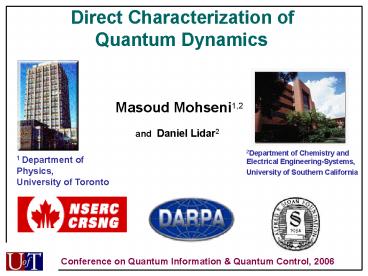Quantum algorithms in the presence of decoherence: optical experiments - PowerPoint PPT Presentation
1 / 18
Title:
Quantum algorithms in the presence of decoherence: optical experiments
Description:
Bell State Measurements. Non-separable. Measurement (e.g. MUB) Joint Single-qubit ... Bell-state generation. Single-qubit rotations. Bell-state measurement ... – PowerPoint PPT presentation
Number of Views:29
Avg rating:3.0/5.0
Title: Quantum algorithms in the presence of decoherence: optical experiments
1
Direct Characterization of Quantum Dynamics
Masoud Mohseni1,2 and Daniel Lidar2
2Department of Chemistry and Electrical
Engineering-Systems, University of Southern
California
1 Department of Physics, University of
Toronto
Conference on Quantum Information Quantum
Control, 2006
2
Motivation
Black Box
Aephraim Steinbergs laboratory at University of
Toronto
- The characterization of dynamics of open quantum
systems - among the central modern challenges of quantum
physics and chemistry - a fundamental problem in quantum information
science and quantum control
- Verifying/Monitoring the performance of a
quantum device - Design of decoherence prevention/correction
methods
3
Quantum Process Tomography
- Subjecting an ensemble of identical quantum
systems (prepared in a member of a set of quantum
states) to the same quantum dynamics, and
measuring the output via quantum state tomography
4
Motivation
- Is it possible to directly characterize the
real-world quantum dynamics, including
decoherence and losses? (i.e., without state
tomography)
Key observation using quantum error detection
schemes one can directly obtain some partial
information about the nature of errors acting on
the state of a quantum system
- How the physical resources scale-up with the
systems degrees of freedom? - Which kind of applications such a theory may
have? - Does entanglement play a fundamental role?
- Does it lead to new ways of understanding/control
ling quantum dynamical systems?
5
We present
An optimal algorithm for complete and direct
characterization of quantum dynamics
- Optimal in the sense of overall required
experimental configurations and quantum
operations over all known quantum process
tomography schemes in a given Hilbert space.
- A Quadratic reduction in the number of
experimental configuration over all separable
quantum process tomography schemes.
- Quantum dynamics is characterized directly,
without any state tomography.
- Quantum error detection is utilized for complete
characterization of dynamics
- Applications for partial characterization of
quantum dynamics.
E.g., Hamiltonian Identification, simultaneous
determination of T1 and T2 in a single
measurement.
6
Outline
- Introduction
- Quantum dynamical maps
- Standard quantum process tomography
- Ancilla-assisted process tomography
- Comparing the required physical resources
- Direct Characterization of Dynamics for two-level
systems - Error detection schemes
- Characterization of quantum dynamical population
- Characterization of quantum dynamical coherence
- Physical realization
- Generalizations and applications
- Conclusion
7
Quantum Dynamical Maps
8
J. F. Poyatos, J. I. Cirac, and P. Zoller, PRL
(97) I.L. Chuang and M.A. Nielsen, J. Mod. Opt.
(97)
Overall number of measurements 4 X 4 16
9
Comparing the Required Physical Resources for n
Qubits
10
Direct Characterization of Superoperator for a
Single Qubit
11
Quantum Error Detection
- Encoding in a larger Hilbert space (with
redundancy) such that any arbitrary error that
may occur on the data can be detected.
D. Gottesman, quant-ph/9705052
12
Characterization of Quantum Dynamical Population
1- Prepare the Input state
13
Characterization of Quantum Dynamical Coherence
1- Prepare the Input state
Sole stabilizer generator
Degenerate stabilizer code
14
5- Calculate the expectation values of a
normalizer (e.g., )
15
Direct Characterization of Superoperator for a
Single Qubit
Measurement
Input state
Output
Normalizer
Stabilizer
N/A
16
Physical Realization
- Bell-state generation
- Single-qubit rotations
- Bell-state measurement
Required physical resources are
E.g.,
Trapped ions and liquid-state NMR possible with
current state of technology
17
Conclusions
- Direct and Complete characterization of quantum
dynamics, without state tomography. - Optimal in the sense of overall required
experimental configurations and quantum
operations over all known quantum process
tomography schemes in a given Hilbert space. - A Quadratic reduction in the number of
experimental configuration over all separable
quantum process tomography schemes. - Introduce error detection schemes to fully
measure the coherence in a quantum dynamical
process.
18
Future Works
- Direct Hamiltonian Identification
- Simultaneous determination of T1 and T2
- Generalization to Higher dimensional systems
- Optimization of the required non-maximally
entangled input states - Continuous characterization of quantum dynamics
?
?
?
References
M. Mohseni and D. A. Lidar, quant-ph/0601033 and
quant-ph/0601034.































